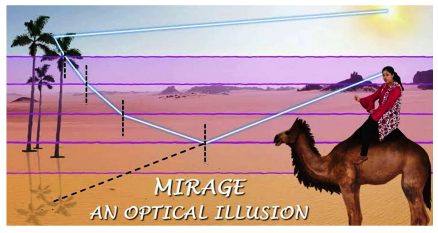
To a distant observer, the light appears to be coming from somewhere below the ground. The observer naturally assumes that light is being reflected from the ground, say, by a pool of water near the tall object.
Such inverted images of distant tall objects cause an optical illusion to the observer. This phenomenon is called mirage. This type of mirage is especially common in hot deserts.
Based on the above facts, answer the following questions:
(a) Which of the following phenomena is prominently involved in the formation of mirage in deserts?
(i) Refraction, Total internal Reflection
(ii) Dispersion and Refraction
(iii) Dispersion and scattering of light
(iv) Total internal Reflection and diffraction.
(b) A diver at a depth 12 m inside water (aμω = 4/3) sees the sky in a cone of semi- vertical angle.
(i) sin-1 \(\frac{4}{3}\)
(ii) tan-1 \(\frac{4}{3}\)
(iii) sin-1 \(\frac{3}{4}\)
(iv) 90°
(c) In an optical fibre, if n1 and n2 are the refractive indices of the core and cladding, then which among the following, would be a correct equation?
(i) n1 < n2
(ii) n1 = n2
(iii) n1 << n2
(iv) n1 > n2
(d) A diamond is immersed in such a liquid which has its refractive index with respect to air as greater than the refractive index of water with respect to air. Then the critical angle of diamond-liquid interface as compared to critical angle of diamond -water interface will
(i) depend on the nature of the liquid only
(ii) decrease
(iii) remain the same
(iv) increase.
The following figure shows a cross-section of a ‘light pipe’ made of a glass fiber of refractive index 1.68. The outer covering of the pipe is made of a material of refractive index 1.44. What is the range of the angles of the incident rays with the axis of the pipe for the following phenomena to occur.

(i) 0 < i < 90°
(ii) 0 < i < 60°
(iii) 0 < i < 45°
(iv) 0 < i < 30°